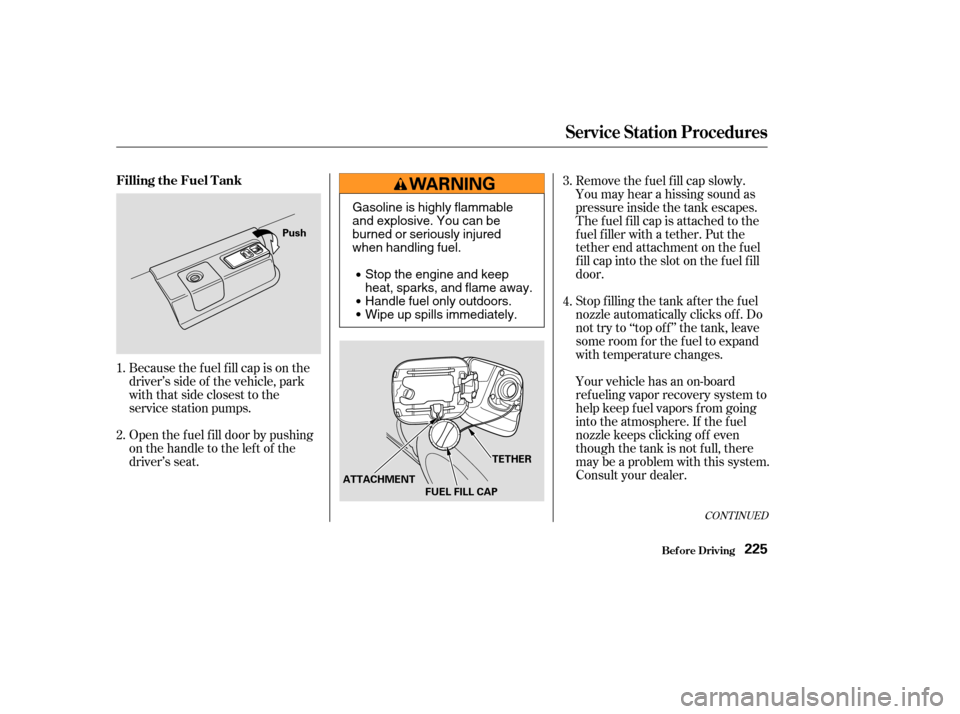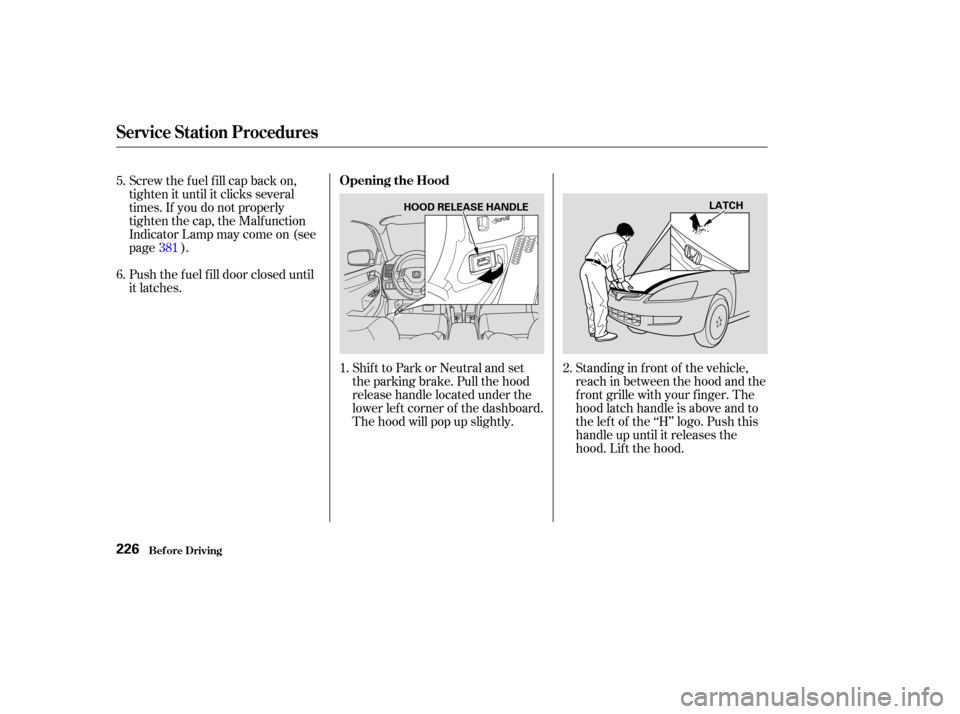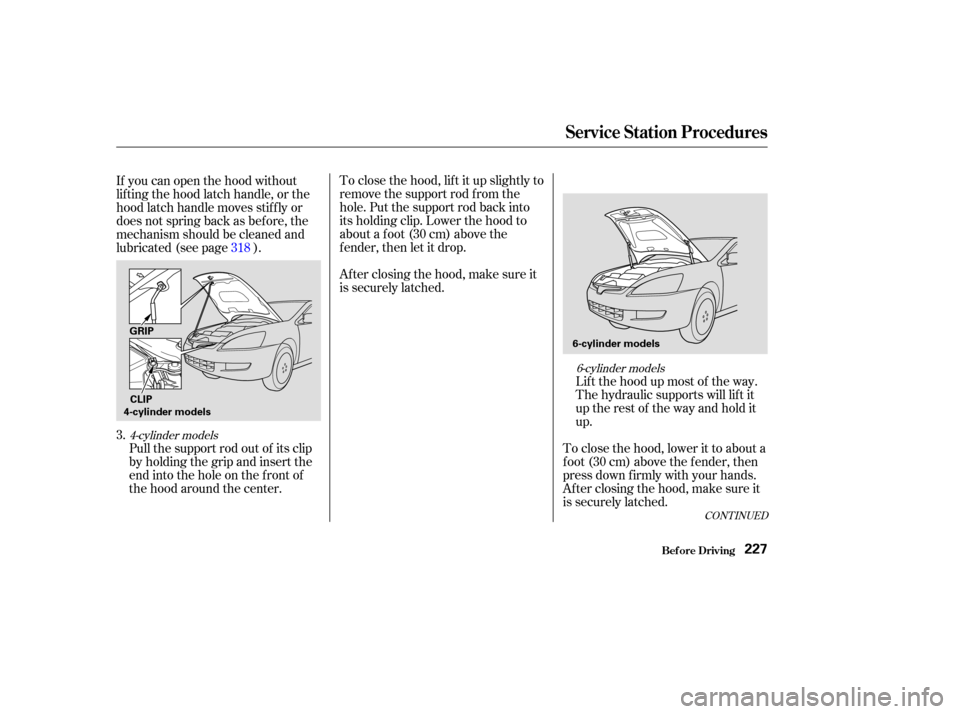2003 HONDA ACCORD COUPE service
[x] Cancel search: servicePage 1 of 429

2003 Accord Coupe Online Reference Owner's Manual Use these links (and links throughout this manual) to navigate through\
this reference.
For a printed owner's manual, click on authorized manuals or go to www.h\
elminc.com.
Contents
Owner's Identification Form
Introduction ........................................................................\
................................................................. i
A Few Words About Safety ........................................................................\
......................................... ii
Your Car at a Glance ........................................................................\
................................................... 2
Driver and Passenger Safety ........................................................................\
...................................... 5
Proper use and care of your car's seat belts, and Supplemental Restraint\
System.
Instruments and Controls ........................................................................\
......................................... 59
Instrument panel indicator and gauge, and how t o use dashboard and steering column controls.
Comfort and Convenience Features ........................................................................\
...................... 121
How to operate the climate control system, the audio system, and other c\
onvenience features.
Before Driving........................................................................\
.......................................................... 223
What gasoline to use, how to break -in your new car, and how to load luggage and other cargo.
Driving ........................................................................\
...................................................................... 239
The proper way to start the engine, shift the transmission, and park, pl\
us towing a trailer.
Maintenance ........................................................................\
............................................................. 271
The Maintenance Schedule shows you when you need to take your car to the\
dealer.
Appearance Care ........................................................................\
...................................................... 355
Tips on cleaning and protecting your car. Things to look for if your car e\
ver needs body repairs.
Taking Care of the Unexpected ........................................................................\
.............................. 363
This section covers several problems motorists sometimes experience, and\
how to handle them.
Technical Information ........................................................................\
............................................. 393
ID numbers, dimensions, capacities, and technical information.
Warranty and Customer Relations (U.S. and Canada) ................................................................409
A summary of the warranties covering your new Honda, and how to contact \
us.
Authorized Manuals (U.S. only) ........................................................................\
.............................. 413
How to order manuals and other tech nical literature.
Index ........................................................................\
........................................................................\
..... I
Service Information Summary
A summary of information you need when you pull up to the fuel pump.
Page 8 of 429

This section gives you important
inf ormation about how to protect
yourself and your passengers. It
shows you how to use seat belts
properly. It explains your Supple-
mental Restraint System. And it tells
you how to properly restrain inf ants
andchildreninyourcar..........
Important Safety Precautions . 6
.............
Your Car’s Saf ety Features . 7
.......................................
Seat Belts .8
...........................................
Airbags .9
..................
Seats and Seat-Backs . 11
..........................
Head Restraints .11
..................................
Door Locks .11
........
Pre-Drive Saf ety Checklist . 12
............................
Protecting Adults .13
.....
1. Close and Lock the Doors . 13
...........
2. Adjust the Front Seats . 14 ............
3. Adjust the Seat-Backs . 15
...
4. Adjust the Head Restraints . 16
5. Fasten and Position the Seat .....................................
Belts .16
....
6. Adjust the Steering Wheel . 18
7. Maintain a Proper Sitting ................................
Position .18
.....
Advice f or Pregnant Women . 19
...
Additional Safety Precautions . 20
........................
Protecting Children .21
All Children Must Be ...............................
Restrained .21
Children Should Sit in the Back ...........................................
Seat .22
The Passenger’s Front Airbag Poses Serious Risks to ...............................
Children .22
If You Must Drive with Several ...................................
Children .24
If a Child Requires Close ..................................
Attention .25
...
Additional Safety Precautions . 25
General Guidelines f or Using ...............................
Child Seats .26
.......................
Protecting Inf ants .30
.........
Protecting Small Children . 34 .......
Protecting Larger Children . 38
Using Child Seats with .....................................
Tethers .42
.............................
Using LATCH .43
Additional Inf ormation About Your .................................
Seat Belts .46
..
Seat Belt System Components . 46
......................
Lap/Shoulder Belt .46
Automatic Seat Belt ...............................
Tensioners .47
...............
Seat Belt Maintenance . 48
Additional Inf ormation About ...........................
Your Airbags .49
........................
SRS Components .49
How Your Front Airbags .........................................
Work .49
...
How Your Side Airbags Work . 51
How Your Side Curtain ..........................
Airbags Work .52
..
How the SRS Indicator Works . 52
How the Side Airbag Cutof f ...........
Indicator Light Works . 53
.............................
Airbag Service .55
...
Additional Safety Precautions . 55
.............
Carbon Monoxide Hazard . 56
...................................
Saf ety Labels .57
Driver and Passenger Saf ety
Driver and Passenger Saf ety
5
Page 58 of 429

Together, airbags and
seat belts provide the best
protection.
Tampering could cause
the airbags to deploy, possibly
causing very serious injury. See page f or f urther inf ormation
and precautions relating to your
airbags.
If rain or spilled water
soaks into a seat-back, it can
prevent the side airbag system
f rom working properly. Improperly
replacing or covering f ront seat-
back covers can prevent your side
airbags f rom inf lating during a
collision.
Your airbag systems are virtually
maintenance-f ree, and there are no
parts you can saf ely service.
However, you must have your car
serviced if :
Any
airbag that has deployed must be
replaced along with the control
unit, automatic seat belt
tensioners, and other related parts.
Do not try to remove or replace
anyairbagbyyourself.Thismust
be done by a Honda dealer or a
knowledgeable body shop.
Take your car to an
authorized Honda dealer as soon
as possible. If you ignore this
indication, the airbags might not
inf late when you need them. 233
Airbag Service
Additional Saf ety Precautions
Donotattempttodeactivateyour
airbags.
Do not t amper wit h airbagcomponent s or wiring f or anyreason.
Do not expose t he f ront seat -backsto water. Do not cover or replace f ront seat -
back covers wit hout consult ing aHonda dealer.
Your airbags ever inf late.
T he SRS indicat or light alert s yout o a problem.
Driver and Passenger Saf ety
Additional Inf ormation About Your Airbags
55
Page 226 of 429

Bef ore you begin driving your Honda,
youshouldknowwhatgasolineto
use, and how to check the levels of
important f luids. You also need to
know how to properly store luggage
or packages. The inf ormation in this
section will help you. If you plan to
add any accessories to your car,
please read the inf ormation in this
section f irst..............................
Break-in Period .224
.........................................
Gasoline .224
.........
Service Station Procedures . 225
................
Filling the Fuel Tank . 225
....................
Opening the Hood .226
...............................
Oil Check .228
.........
Engine Coolant Check . 230
...............................
Fuel Economy .231
............................
Car Condition .231
...........................
Driving Habits .231
...
Accessories and Modif ications . 232
.............................
Carrying Cargo .234
Bef ore Driving
Bef ore Driving223
Page 227 of 429

During this period:Avoid full-throttle starts and rapid
acceleration.
Avoidhardbraking.Newbrakes
need to be broken-in by moderate
use f or the f irst 200 miles (300
km).
Help assure your car’s f uture
reliability and perf ormance by paying
extra attention to how you drive
during the f irst 600 miles (1,000 km).
Youshouldfollowthesesamere-
commendations with an overhauled
or exchanged engine, or when the
brakes are relined.
Do not change the oil until the
recommended time or mileage
intervalshowninthemaintenance
schedule. Your Honda is designed to operate
on unleaded gasoline with a pump
octane number of 86 or higher. Use
of a lower octane gasoline can cause
a persistent, heavy metallic rapping
noise in the engine that can lead to
mechanical damage.
In Canada, some gasolines contain
an octane-enhancing additive called
MMT. If you use such gasolines,
your emission control system
perf ormance may deteriorate and
the Malf unction Indicator Lamp on
your instrument panel may turn on.
If this happens, contact your
authorized Honda dealer f or service.
Using gasoline containing lead will
damage your vehicle’s emissions
controls. This contributes to air
pollution. We recommend gasolines containing
detergent additives that help prevent
f uel system and engine deposits. If you drive with the low engine
speed (below than about 1,000 rpm),
you may f eel the engine knocking. In
this case, you can use premium
unleaded gasoline with a pump
octane number of 91 or higher to
prevent the engine f rom knocking.
On EX-V6 with manual transmission
Bef ore Driving
Break-in Period Gasoline
Break-in Period, Gasoline
224
Page 228 of 429

Open the f uel f ill door by pushing
onthehandletotheleftof the
driver’s seat. Because the f uel f ill cap is on the
driver’s side of the vehicle, park
with that side closest to the
service station pumps.Remove the f uel f ill cap slowly.
You may hear a hissing sound as
pressure inside the tank escapes.
The fuel fill cap is attached to the
f uel f iller with a tether. Put the
tether end attachment on the fuel
f ill cap into the slot on the f uel f ill
door.
Stop f illing the tank af ter the f uel
nozzle automatically clicks of f . Do
not try to ‘‘top of f ’’ the tank, leave
some room f or the f uel to expand
with temperature changes.
Your vehicle has an on-board
ref ueling vapor recovery system to
help keep f uel vapors f rom going
into the atmosphere. If the fuel
nozzle keeps clicking of f even
though the tank is not full, there
maybeaproblemwiththissystem.
Consult your dealer.
3.
4.
1.
2.
CONT INUED
Service Station Procedures
Bef ore Driving
Filling the Fuel Tank
225
FUEL FILL CAP TETHER
Push
ATTACHMENT
Gasoline is highly flammable
and explosive. You can be
burned or seriously injured
when handling fuel.Stop the engine and keep
heat, sparks, and flame away.
Handle fuel only outdoors.
Wipe up spills immediately.
Page 229 of 429

Standing in f ront of the vehicle,
reach in between the hood and the
f ront grille with your f inger. The
hood latch handle is above and to
the lef t of the ‘‘H’’ logo. Push this
handle up until it releases the
hood. Lif t the hood.
Shift to Park or Neutral and set
the parking brake. Pull the hood
release handle located under the
lower lef t corner of the dashboard.
The hood will pop up slightly.
Screw the f uel f ill cap back on,
tighten it until it clicks several
times. If you do not properly
tighten the cap, the Malfunction
Indicator Lamp may come on (see
page ).
Push the f uel f ill door closed until
it latches.
1. 2.
5.
381
6.
Service Station Procedures
Bef ore Driving
Opening the Hood
226
HOOD RELEASE HANDLE LATCH
Page 230 of 429

CONT INUED
To close the hood, lif t it up slightly to
remove the support rod f rom the
hole. Put the support rod back into
its holding clip. Lower the hood to
about a f oot (30 cm) above the
fender,thenletitdrop.
After closing the hood, make sure it
is securely latched.Lif t the hood up most of the way.
The hydraulic supports will lif t it
uptherestof thewayandholdit
up.
To close the hood, lower it to about a
f oot (30 cm) above the f ender, then
press down f irmly with your hands.
After closing the hood, make sure it
is securely latched.
If you can open the hood without
lifting the hood latch handle, or the
hood latch handle moves stif f ly or
does not spring back as bef ore, the
mechanism should be cleaned and
lubricated (see page ).
Pull the support rod out of its clip
by holding the grip and insert the
end into the hole on the f ront of
the hood around the center.
3. 318
6-cylinder models
4-cylinder models
Bef ore Driving
Service Station Procedures
227
GRIP
CLIP
4-cylinder models 6-cylinder models